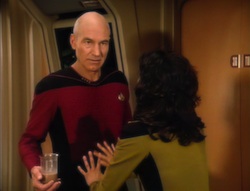My apologies for being a day late with this rewatch. I just hope I’m not a dollar short as well…
“Q Who”
Written by Maurice Hurley
Directed by Rob Bowman
Season 2, Episode 16
Production episode 40272-142
Original air date: May 8, 1989
Stardate: 42761.3
Captain’s log: After a trip to engineering results in hot chocolate being spilled all over his uniform by Ensign Sonya Gomez, an eager, motor-mouthed recent Academy graduate, Picard is on his way to change his uniform, when he finds himself suddenly in a shuttlecraft that is very far from the Enterprise. On the shuttle with Picard is Q.
Picard angrily points out that Q promised not to interfere with his ship again, which is a complete misremembering of the ending of “Hide and Q,” when Q promised to stay out of humanity’s path forever. Instead, both Picard and Q remember it as him not interfering with the Enterprise, which Q gets around by kidnapping him to the shuttle far from the ship. (What makes this funnier is that Maurice Hurley wrote both scripts.) But leaving that minor inconsistency aside, we are treated to Q having a proposal for Picard—which Picard refuses to listen to. Q points out that he’s ageless and can wait as long as he needs to, to which Picard blandly says that the Enterprise will continue with Riker as captain.
Back on the ship, Guinan has a feeling that something is wrong and contacts the bridge. Troi has a similar feeling and anxiously comes onto the bridge asking where the captain is. Riker soon realizes that Picard is missing and engages in a search.
That search is cut off when Picard finally agrees to listen to Q’s proposal in return for being returned to the ship. Q brings them to a Ten-Forward that is empty of all save Guinan—who, it turns out, has had dealings with Q in the past.
Q’s proposal is simple: he wants to join the crew. After the events of “Hide and Q,” the Q-Continuum kicked him out. Remembering all the good times he had on the Enterprise in that episode and “Encounter at Farpoint,” he decided to come on board—already the home of the “indigent, the unwanted, the unworthy.” Ultimately, however, Picard doesn’t trust him. Q is willing to concede that point—but he does insist that they do need him, that they’re not ready for what’s waiting for them in the parts of the galaxy they’re heading toward. Q also comments that they’re moving faster than expected or than they should—to which Picard tartly asks by whose calculation, a question for which Q has no answer.
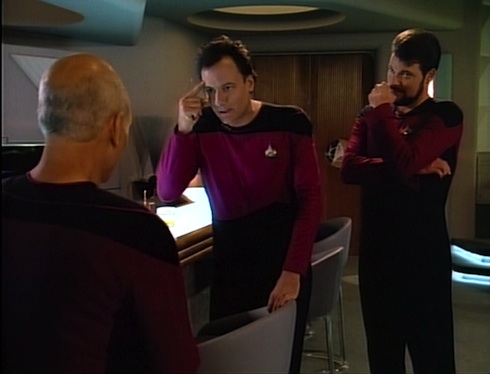
Picard and Riker continue to refuse to let Q join them. They insist that they are ready for whatever comes next. Q angrily decides to test that hypothesis: he sends the Enterprise seven thousand light-years away to the system J25 and then disappears. Guinan, whose people are from this part of the galaxy, tells them to start running now.
But because they’re Starfleet officers who don’t listen to good advice (and, to be fair, weren’t really trained to take tactical advice from bartenders), they decide to stick around for a bit. There’s a planet nearby that has a system of roads that indicate there was once civilized life, but all the cities have been seemingly scooped off the planet.
Then they encounter a cube-shaped ship. Data’s scan reveals an uncentralized design: no bridge, no engineering section, no living quarters. Guinan identifies the ship as belonging to the Borg, a species who killed several members of Guinan’s people and destroyed their cities.
An advance scout appears in engineering. Worf is able to kill the scout, but another one appears, and this one has a force field that protects him from the phaser blast. He scavenges parts off his dead comrade and transports away, while the first scout disintegrates.
The Borg don’t have a single leader, but are a collective consciousness. They contact the Enterprise long enough to threaten them, then hit the ship with a tractor beam. They carve out a section of the saucer that has eighteen people in it and take it on board. Worf manages to damage twenty percent of the ship, which releases the tractor beam. The cube now reading as all but inactive, Riker, Data, and Worf beam over.
Although no life form readings are detected, there are thousands of Borg on the ship, most in a form of stasis. One Borg walks past the away team, completely ignoring them. They even find a nursery, with children who are mostly organic, unlike the adult Borg who are as much machine as biological.
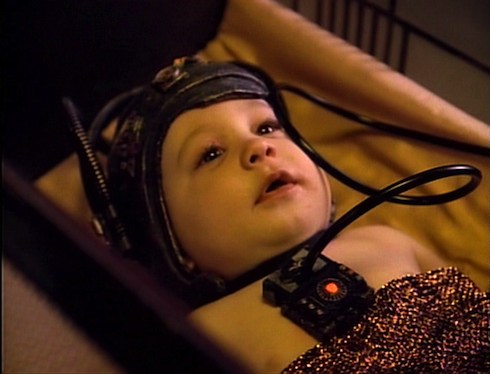
Q describes them as the ultimate user—they don’t care about political conquest, they just want technology they can consume.
Data realizes that the ship is engaged in self-repair. Picard immediately orders the away team beamed back and they run away very fast. However, as fast as they go, the Borg continues to gain on them. Photon torpedoes from the Enterprise have no effect on the Borg, but a Borg weapon succeeds in wiping out their shields.
Helpless, facing destruction, Picard asks Q to end this, admitting that, yes, he does need Q’s help. At this admission, Q smiles and sends the Enterprise back to where they were when Q showed up, safe and sound—except, of course, for the eighteen members of the crew who didn’t make it.
They limp toward a starbase to fix the damage, and in conversation with Guinan, Picard realizes that the Borg knows about the Federation now, and they will be coming.
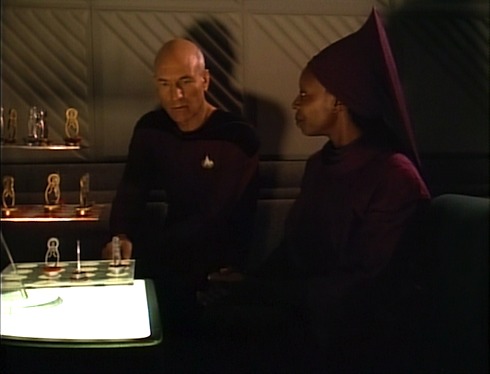
Thank you, Counselor Obvious: Troi senses that Picard is missing even as Guinan senses Q’s presence, and she is the one who realizes that the Borg has a single collective consciousness rather than being individual, separate entities.
There is no honor in being pummeled: Q once again calls Worf “micro-brain,” and Worf’s response is to snarl and move forward menacingly before Picard asks him to leave the room. Worf also gets to prove the Borg’s resiliency by killing one of them and destroying twenty percent of their ship, only to have both events rendered pointless.
Syntheholics Anonymous: Guinan and Q have a past that is left unexplained, and which would unfortunately remain so (though it will come up again in “Déjà Q”), but Guinan does appear to have at least some ability to resist Q’s powers. Also, while it’s not made explicit, Guinan certainly appears to be the one who clears Ten-Forward, since just one phrase from her gets La Forge and Gomez to leave the lounge in a hurry.
Welcome aboard: John deLancie makes his triumphant return as Q, while Whoopi Goldberg adds to Guinan’s mystery, and Colm Meaney returns as the rock-steady O’Brien. Lycia Naff makes the first of two appearances as Ensign Sonya Gomez, a role that was originally intended to be recurring, but never went beyond her second appearance in “Samaritan Snare.”
I believe I said that: “You can’t outrun them, you can’t destroy them. If you damage them, the essence of what they are remains. They regenerate and keep coming. Eventually, you will weaken—your reserves will be gone. They are relentless.”
Q, describing the Borg.
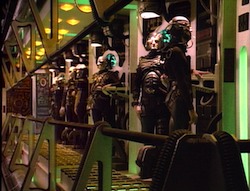
Trivial matters: This is, of course, the first appearance of the Borg, who would become one of Trek‘s biggest villains. The Borg continue to appear on TNG (on the small and big screens), as well as the future spinoffs Deep Space Nine, Voyager, and Enterprise.
Technically, it’s their second appearance, after a fashion: dialogue from Data makes it clear that what happened on the planets in the J25 system is exactly the same as what happened to the planets in “The Neutral Zone.” Writer Hurley’s original plan was for the Borg to be part of a trilogy that would introduce them across the first and second seasons, but it was skoshed by the writers strike. The first part of the trilogy was to be “Conspiracy,” as Hurley’s original conception was that the Borg would be insectoid—which proved impractical on a TV show budget—and that the alien parasites were part of what would be established as the Borg Collective.
While the Borg themselves won’t return until “The Best of Both Worlds” at the end of the third season, Starfleet’s concern about their eventual arrival will remain in the background in the interim, most notably in “Peak Performance.”
The Borg have also appeared in several novels and comic books, most notably the Destiny trilogy by David Mack, which establishes the origin of the Borg, involving time travel, a species known as the Caeliar, and the Earth starship Columbia (established on Star Trek: Enterprise).
Guinan plays three-dimensional chess with Picard at the end of the episode, a game played often by Kirk and Spock in the original series.
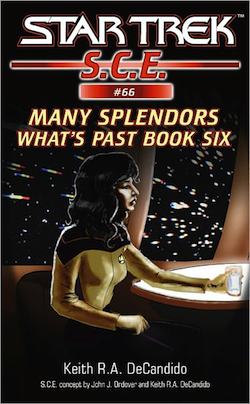
While Gomez never became a recurring character on screen, she did become a regular in prose: Commander Sonya Gomez was one of the two leads in the Starfleet Corps of Engineers series that was published monthly in eBook form from 2000-2007, and most of which has been released in print form since 2002. Gomez was established in the series—which takes place eleven years after this episode—as being first officer on the U.S.S. da Vinci, and also head of that ship’s S.C.E. team. She’d go through quite a bit over the course of the series, including her fiancée being killed. In the aforementioned Destiny trilogy and the novel A Singular Destiny by your humble rewatcher, taking place five years after the S.C.E. series ended, she’s established as being captain of the da Vinci after Captain Gold retired. Some of the other stories that focused on Gomez included Invincible (by Mack and myself), Enigma Ship (by J. Steven York & Christina F. York), Wildfire and Failsafe (by Mack), Identity Crisis (by John J. Ordover), War Stories, Breakdowns, and Many Splendors (all by me)—that last being a flashback to her time on the Enterprise, including a more detailed look at her part in this episode. (Oh, and the Corps of Engineers series establishes that, following this episode, Gomez swore off hot chocolate, drinking only Earl Grey Tea as penance for spilling the beverage on Picard.)
The novels Q & A by me and Greater than the Sum by Christopher L. Bennett both established that all eighteen crew members were assimilated by the Borg, and several of them were named in Q & A: Lieutenant Rebekah Grabowski, Ensign Franco Garcia, Lieutenant Jean-Claude Mbuto, Lieutenant T’Sora, Ensign Gldrnksrb, and Ensign Soon-Tek Han. Han also appeared in both Many Splendors and A Singular Destiny.
Make it so: “I need you!” It’s funny, every other one of Maurice Hurley’s writing credits are collaborations or rewrites of other people’s stories, and some of the other scripts from the past year or so had uncredited rewrites by him in his capacity as co-executive prodcuer. None of them particularly stood out as great episodes, particularly not his last time writing Q in “Hide and Q,” which Hurley actually took the pseudonym of “C.J. Holland” for.
But this is his first solo script, and it’s one of the best hours of TNG.
This is pretty much a flawless episode. The dialogue crackles, with some wonderful lines. Rob Bowman’s direction is superb, creating tremendous tension and suspense.
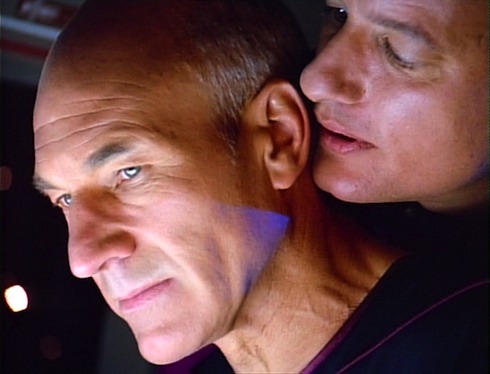
John deLancie gives one of his best performances as Q, modulating seamlessly from smarmy to silly to menacing at the blink of an eye. LeVar Burton does an excellent job as kindly supervisor and mentor figure for Gomez. Whoopi Goldberg brings mystery and depth to Guinan. And Sir Patrick Stewart, as always, just kills: his stubbornness with Q in the shuttle, his arrogance and smugness (and it’s very much that, despite his protestations that it’s resolve) with Q in Ten-Forward, his frustration at his inability to negotiate with the Borg, and his desperation in asking Q for help at the end.
The Borg would become the subject of some of the best and worst Trek episodes (and one excellent movie), but there’s no denying that they became one of the most important Trek villains, and their introduction in this episode is phenomenal. They are menacing, frightening, and so very different from the other Trek villains (as Q himself spells out early on). Their introduction is TNG at its finest.
Warp factor rating: 10
Keith R.A. DeCandido has written a ton of Star Trek fiction, but has never written the Borg. Go fig’. He did write Q, though, in the novel Q & A, which explained why Q felt it was important to introduce humans to the Borg this soon. His most recent novels are Guilt in Innocence, part of “Tales from the Scattered Earth,” a shared-world science fiction concept, and the fantastical police procedurals SCPD: The Case of the Claw and Unicorn Precinct. Find out more about Keith at his web site, which is a portal to (among many other things) his Facebook page, his Twitter feed, his blog, and his podcasts, Dead Kitchen Radio, The Chronic Rift, and the Parsec Award-winning HG World.










